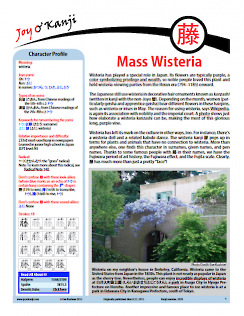藤
wisteria
Kanji 2078
Thank you for visiting this Character Home Page. Below you'll find a synopsis of the essay. If you wish to read the full text, the PDF of the essay is available for purchase to the right.
From wisteria-viewing parties to hair ornaments to a type of doll and dance, wisteria has left its mark on Japanese culture. The 藤 kanji appears in the names of colors, plants, and animals, some with no connection to this vine. Above all, one finds 藤 in people's names. Thus, we have the Fujiwara period of art history, the Fujiwara effect, and the Fujita scale of tornado intensity.
Revision history:
May 9, 2024: p. 16: Deleted a broken link.
Feb. 23, 2024: p. 12: Changed Kiyomasa Kato's birth year to 1562.
Dec. 21, 2023: pp. 1 and 4: Fixed broken links.
Oct. 27, 2023: p. 2: Deleted the sidebar under the Etymology Box because once I corrected an error, I realized that that text was no longer relevant.
Feb. 24, 2022:
- p. 2, Etymology Box: Added a Henshall etymology.
- p. 19: Fixed a graphics problem and added a link to the Kanshudo games.
Jan. 30, 2018: Fixed some broken links. Also corrected the last kanji in an artist's name on p. 13. The name should be written as 伊藤若冲.
Apr. 3, 2015: Fixed a typo on p. 4 in the wisteria dolls caption and then reworked the text a bit.
Mar. 27, 2015: Originally published.



Comments